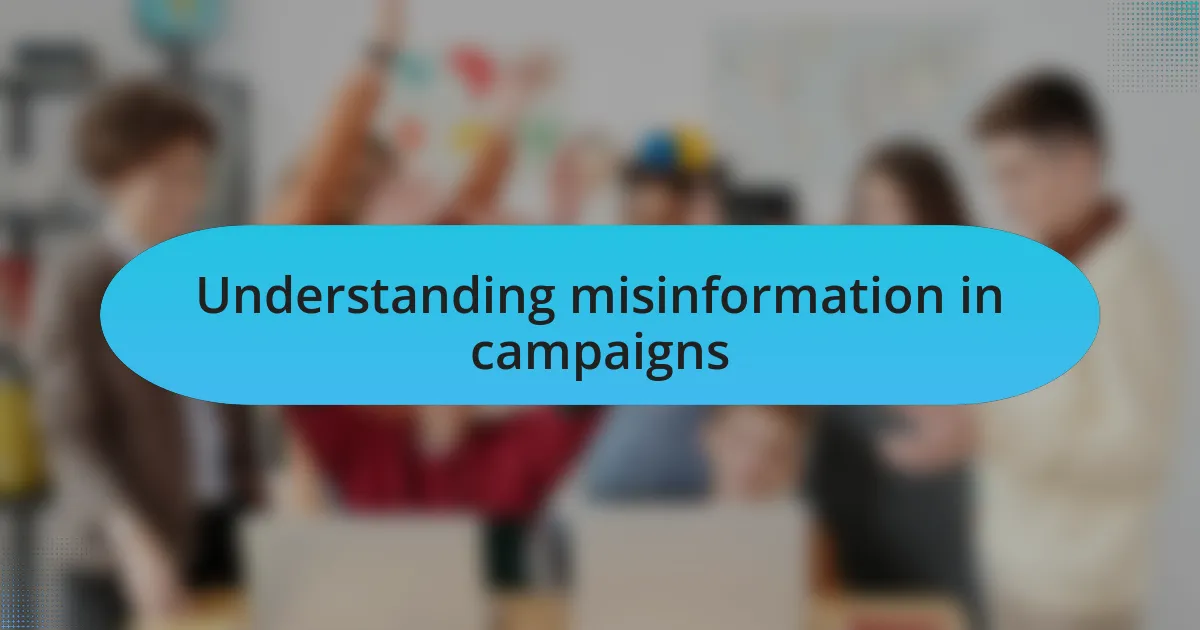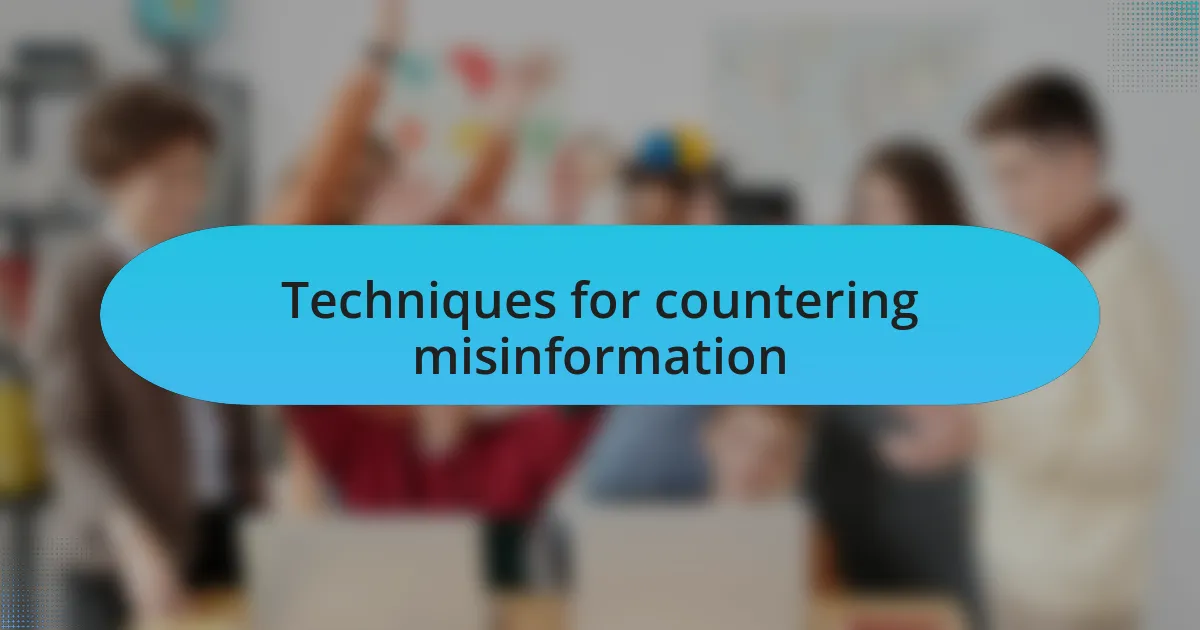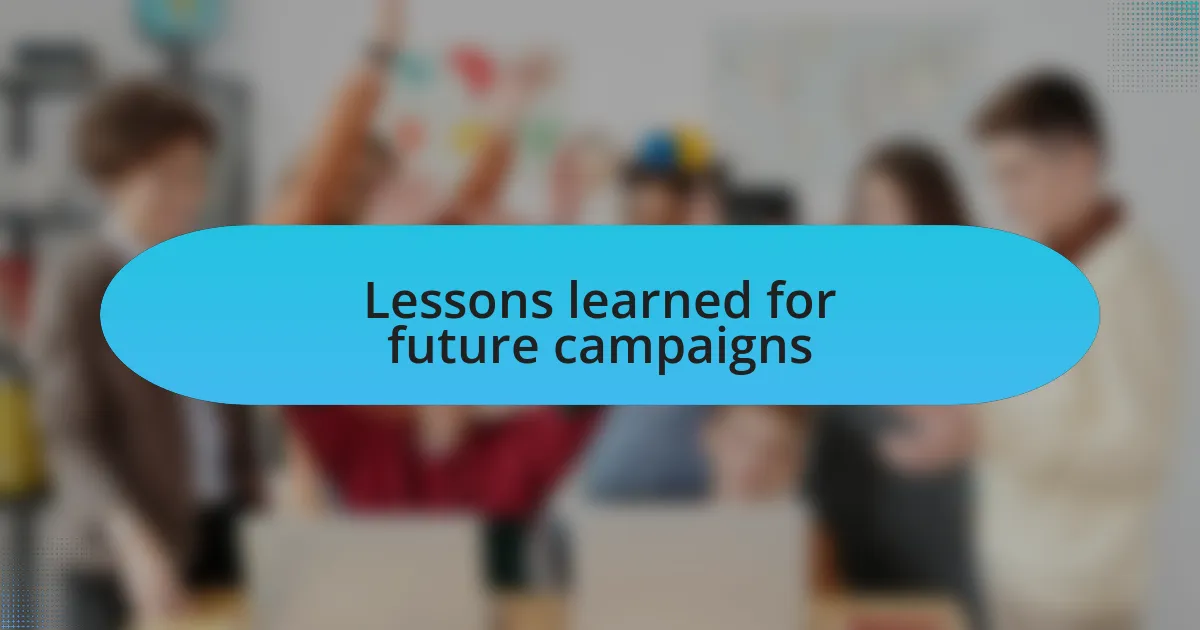Key takeaways:
- Misinformation in campaigns often originates from unverified sources, emphasizing the need for critical thinking and discussions within student communities.
- Student union campaigns are essential for amplifying student voices and fostering a sense of community, while also offering valuable learning experiences like teamwork and public speaking.
- Strategies such as cross-checking sources, analyzing language, and engaging in dialogues with differing viewpoints are effective in identifying misinformation.
- Promoting media literacy, responsible social media use, and collaboration among campus organizations are key techniques for countering misinformation and building a more informed community.

Understanding misinformation in campaigns
Misinformation in campaigns can spread like wildfire, especially when emotions run high. I recall a time when I participated in a student election where exaggerated claims about candidates dominated social media feeds. It made me wonder: How can we distinguish fact from fiction in such a cluttered landscape?
Understanding the sources of misinformation is crucial. For instance, during my involvement in a campaign, I noticed that unverified information often stemmed from anonymous accounts or poorly sourced articles. It was frustrating, as many students seemed to take these statements at face value. Why are we so quick to accept something just because it resonates with our views?
Beyond just identifying misinformation, we must reflect on its impact. When I encountered false narratives, it felt like we were all losing sight of the true issues that mattered. I found myself asking: What responsibilities do we have in ensuring our peers are informed? It’s essential to engage in discussions that emphasize critical thinking, encouraging others to question rather than just accept.

Importance of student union campaigns
Effective student union campaigns serve as a powerful platform for students to voice their concerns and advocate for their needs. I remember my first campaign, where we focused on mental health resources. It was exhilarating to see how a well-organized campaign could spark conversations and bring about real change in campus policies.
Without campaigns, student voices might go unheard, leading to a disconnect between administration and the student body. I often felt that when we rallied together around a cause, it wasn’t just about presenting demands; it was about fostering a sense of community. I found that these campaigns could unite diverse student groups around common interests, enhancing our collective power and impact.
Candidly, student union campaigns also provide invaluable learning experiences. I’ve learned essential skills such as teamwork, public speaking, and even digital literacy through these initiatives. Have you ever participated in a campaign that changed your perspective on an issue? For me, it reinforced the idea that active engagement is key to shaping our university experience and ensuring our voices are respected.

Strategies for identifying misinformation
One of the most effective strategies I’ve found for identifying misinformation is to cross-check sources. Whenever I come across a claim that seems exaggerated or dubious, I immediately look for multiple reputable sources that report the same information. It’s like piecing together a puzzle; when different pieces fit together, it gives me more confidence in the truthfulness of the message. Have you noticed how easy it can be to take things at face value but how rewarding it feels to uncover the facts?
Another approach has been to analyze the language used in the information presented. Sensationalized wording often raises red flags for me. For instance, when I see phrases like “everyone is saying” or “you won’t believe what happened,” I instinctively question the credibility. This kind of emotional manipulation aims to provoke a reaction rather than inform, which I’ve learned to spot with practice. Have you ever caught yourself reacting before fully understanding the context?
Engaging with different perspectives also plays a crucial role in my strategy to identify misinformation. During a campaign I worked on, I made it a point to discuss potential issues with peers who held differing viewpoints. Those discussions often revealed gaps in my own understanding and helped clarify what was factual versus what was false. This experience taught me that open dialogue is not just about defending your stance; it’s also about being open to the possibility that sometimes, what you believe needs a second look. How do you approach challenging conversations that force you to reconsider your views?

Techniques for countering misinformation
When it comes to countering misinformation, one technique I’ve found particularly effective is promoting media literacy among peers. In my experience, hosting workshops where we dissect news articles together has been eye-opening. It’s fascinating to see how understanding the basics of media production can empower everyone to question the sources they encounter. Have you ever realized that knowing how to read between the lines can drastically change your perspective?
Another valuable technique is leveraging social media responsibly to correct false claims. I’ve made it a point to engage directly with posts that spread misinformation, providing evidence and rational arguments to counter false narratives. When I took the time to craft a thoughtful response rather than just dismissing the claim, it felt rewarding to engage in meaningful discourse. Isn’t it amazing how one well-thought-out comment can spark discussion and encourage others to think critically?
Lastly, collaborating with campus organizations to develop unified messages has proven beneficial in creating a strong front against misinformation. During an election cycle, for example, I worked with various student groups to ensure everyone delivered consistent and accurate information. This not only built trust but also cultivated a shared sense of responsibility among students. Have you experienced the power of collaboration in amplifying correct narratives? It demonstrates how collectively, we can create a more informed community.

Results from tackling misinformation
Tackling misinformation has produced some remarkable results, especially in fostering a culture of critical thinking among students. I recall a time when, after organizing a media literacy workshop, a participant approached me and shared how they now felt empowered to challenge false narratives online. It struck me how a single gathering could ripple out, inspiring individuals to engage thoughtfully rather than passively consume information. Isn’t it incredible how a little knowledge can spark such change?
In my experience, the direct engagement on social media yielded tangible results too. I remember responding to a misleading claim about a campus event, armed with facts and a personal story from that event. The response I received was unexpected; not only did others endorse my comments, but it also prompted further discussion. It made me realize that by being open and relatable, I could transform a potential misinformation moment into a meaningful conversation. Have you ever been in a situation where your words influenced the way people viewed a topic?
Collaboration across various campus organizations has also led to a unified front that became essential in combating misinformation. I distinctly recall a campaign where clubs united to distribute accurate information during exam weeks. It was heartening to see how students began to trust these unified messages, fostering a supportive environment. The shared effort not only built stronger connections among groups but also reassured students that they were part of a community that valued truth. Reflecting on this, I often wonder: what other collaborative strategies could we explore to further enhance our collective ability to tackle misinformation?

Lessons learned for future campaigns
One vital lesson I learned is the importance of transparency in communication. During a campaign where I had to address a wave of misinformation, I found that being upfront about our sources fostered trust. I remember sharing the research process openly, and several students expressed gratitude for the honesty. It made me realize that when you demystify your approach, it not only builds credibility but also invites others to engage in the conversation more deeply. Isn’t it refreshing when everyone knows they can rely on the information shared?
Another key takeaway is the potential of storytelling in combating misinformation. I recall a time when a friend shared a compelling personal experience related to a widely circulated myth. By sharing his story during one of our discussions, he made the truth resonate with others in a way that statistics alone couldn’t achieve. This reinforced my belief that personal narratives create connections that foster understanding. How often do we underestimate the power of our own stories in shaping opinions?
Lastly, I discovered that continuous education is essential in the fight against misinformation. In my journey, I organized follow-up sessions after our initial workshops, ensuring the knowledge we imparted remained fresh and relevant. After one session, a student approached me excitedly to discuss new findings related to misinformation. This showed me that keeping the conversation going encourages a culture where critical thinking is not just a one-time effort but an ongoing practice. Doesn’t it make you wonder how we can encourage this type of continuous learning across all campuses?